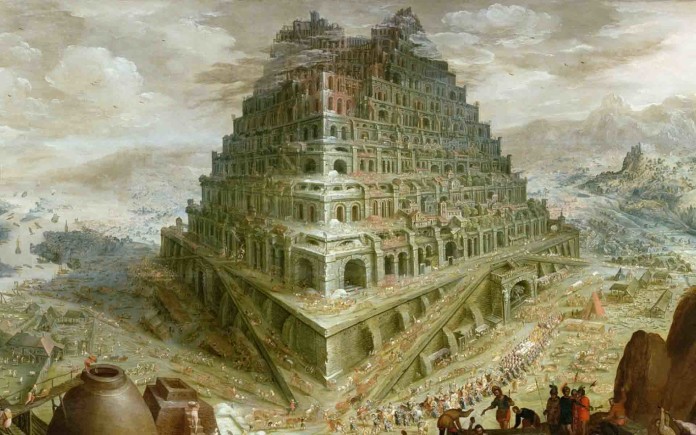Another line of evidence for the reality of the Tower of Babel is the name Peleg (Genesis 10:25; 11:16, 17, 18, 19; 1 Chronicles 1:19, 25), which, according to the Bible, means “divide,” or “split” (Genesis 10:25; 1 Chronicles 1:19) with a play-on the Hebrew name Peleg and the Hebrew root word “palag.” The Hebrew word palag פַּלַּג occurs also in Job 38:25 describing the water channels being split and Psalms 55:9 describing the LORD dividing the tongues at Babel. Obviously the name Peleg was given to commemorate the division of the earth’s inhabitants as indicated in Genesis 11:1 “And the whole earth was of one language, and of one speech.” This cannot refer to the earth as land mass since the earth had one language, thus it was the inhabitants of the whole earth. Josephus acknowledges this saying, “Heber begat Joetan and Phaleg: he was called Phaleg, because he was born at the dispersion of the nations to their several countries; for Phaleg among the Hebrews signifies division.”1)Josephus, The Works of Josephus, Complete and Unabridged, Tran. William Whinston (Peabody. M.A.: Hendrickson Publishers, 1988), p. 37; accessible at http://www.ccel.org/j/josephus/works/ant-1.htm
Peleg must have been born immediately after this event, if not named as a prophetic warning, similar to the way the Passover was named to commemorate how the angel of death passed over the houses with blood on the door (Exodus 12:11, 13, 21, 23, 27, 43, 48). Another ancient author Strabo in his Geographies mentions “Pelasgi were an ancient race”2)Strabo, The Geography of Strabo. Literally translated, with notes, in three volumes. London. George Bell & Sons. 1903. Accessible at http://www.perseus.tufts.edu/hopper/text?doc=Perseus:text:1999.01.0239
Book. 5, Chap. 2, sect. 4; also see, Bk. 8, chap. 6. Sect. 9; Bk. 9, chap. 11, sect. 22
and quotes a number of times from an older source, Homer’s Odyssey and Iliad who mentions the “Pelasgians.”3)Strabo, The Geography of Strabo. Literally translated, with notes, in three volumes. London. George Bell & Sons. 1903. Accessible at http://www.perseus.tufts.edu/hopper/text?doc=Perseus:text:1999.01.0239
Book. 5, Chap. 2, sect.; quoting Homer’s Odyssey xix. 175, Iliad xvi. 223, Iliad ii. 840
Peleg was certainly a historical figure whose ancestors were known by ancient authors and the fact that his name carries a reminder of the time God divided the world inhabitants from the Tower of Babel.
The fact that we have separated nations todays bares a witness of the consequence of the Tower of Babel; and many of these nations have ancient records of the forefathers genealogies that recognize the resemblance of the biblical account. Bodie Hodge explained:
Historians such as Josephus (1st century), Snorri Sturlusonor (13th century), James Anderson (1732), Nennius (9th century), and many others have commented on various cultures and their genealogical records in the past and the origins of various peoples.
Though there are many to pick from, a few examples of tables of nations could show that historians, especially prior to evolutionary re-writing of history which is common in the past 150 years, even unbeknownst to themselves sometimes, were offering a great confirmation of Genesis….
Some genealogies connect prominent modern houses and royal lines with the Table of Nations listed in the Bible. Anglo-Saxon chronologies feature six royal houses that go back to Noah. In these genealogies, Noah is found on the top of the lists in many of these documents, some of which feature variant spellings such as Noe or Noa….
Chinese records also describe Nuah with three sons, Lo Han, Lo Shen, and Jahphu, according to the Miautso people of China.4)Bodie Hodge, Tower of Babel: The Cultural History of Our Ancestors, Master Books, (Green Forest, AR, 2013), pp. 75-78
Furthermore, the dates of these civilizations determine that they arose shortly after the dispersion from Babel.5)Larry Pierce, “In the Days of Peleg: Ancient Documents Are Consistent with the Total Accuracy of the Bible’s Chronology.” Originally published in Creation 22, no 1 (December 1999): 46-49.; accessible at https://answersingenesis.org/bible-history/in-the-days-of-peleg/ Bodie Hodge writes:
Renowned chronologist Archbishop James Ussher placed the time of Babel at 106 years after the Flood, near the time Peleg was born….
…Archbishop Ussher’s reckoning placed the date of Babel near 2242 B.C. …
Not long after this, Babylon (2234 B.C.), Egypt (2188 B.C.), and Greece (2089 B.C.) began.6) Bodie Hodge, Tower of Babel: The Cultural History of Our Ancestors, Master Books, (Green Forest, AR, 2013), pp. 37-39
References

